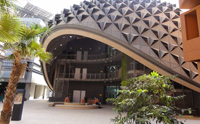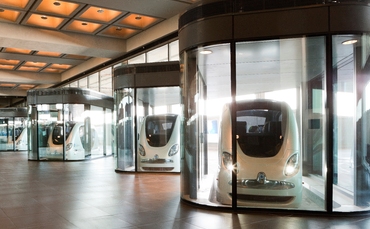What next for the world's greenest city?
 Raising a city out of the desert and powering it entirely using renewable energy was always going to be a pretty big ask, and that was before the global property crisis struck, presenting the biggest challenge yet to the world’s most ambitious green building project.
Raising a city out of the desert and powering it entirely using renewable energy was always going to be a pretty big ask, and that was before the global property crisis struck, presenting the biggest challenge yet to the world’s most ambitious green building project.The first phase of Masdar City on the outskirts of Abu Dhabi is well under way, with around 300 students already resident at the settlement’s purpose-built university. But without commercial investment, the city’s cutting-edge green technology, super-energy efficient buildings, and electrified transport network could prove a $22bn white elephant.
That’s where Alan Frost comes in. The cheerful Australian jokes he is “the unelected mayor of Masdar City”, but is much more serious about bringing investment to the site, currently bankrolled by the Abu Dhabi government as a means of attracting clean tech expertise and investment to a country keen to diversify its economy away from oil and gas.
He has already enjoyed some significant success. Siemens is building an enormous 18,000 square metre headquarters for 2,000 workers, which may look like little more than a hole in the ground at present, but is scheduled to be ready by the end of this year.
However, the German engineering giant is the only confirmed large-scale commercial tenant to date, a situation that has prompted a change of tack for the Masdar project whereby it is now seeking to attract smaller businesses.
Frost explains that a model pioneered by Korean technoparks where firms are offered subsidised rents and the opportunity to share facilities could soon bear fruit for Masdar.
“As a result of the model [Korean companies] end up employing the most amazing number of people and generating businesses that end up being billion dollar firms,” he says. “So we’re working with them on a study to see what it’s going to take to bring Korean companies into Masdar.
“The issue there is they tend to be SMEs [and] tend not to want to take long term leases. Big companies are big enough and ugly enough to look after themselves [but] the smaller companies want a desk or a work station. So what’s happening is … smaller countries – Sweden, Denmark, Switzerland – are saying we need to come up with a method by which their companies can engage with Masdar, but not be locked in.”
The global slowdown and the effects of the Arab Spring on investment in the region have also meant Masdar has to be a more flexible developer than it initially intended.
“There are a number of uses we’re looking at that are very complementary to Masdar, but not mainstream real estate,” Frost says. “So if someone wanted to come here and run a small PV assembly plant, we think that fits. Two people [are] talking to me about wanting to take their own plots… looking at things like schools, hotels, service departments, clinics and residential. I think that’s recognising the inherent value in Masdar.”
Despite having no commercial premises completed as yet, Masdar has 80 companies lined up to fill office and other commercial space. Some of these firms are so keen to be part of the project they have taken space in sheds on the site while they wait for their buildings to be completed.
Walking around the site it is easy to understand their enthusiasm. The Norman Foster designed buildings are uniquely oriented to ensure maximum shade and funnel air through the narrow streets to such great effect that it is typically 10 degrees cooler in the centre of Masdar than it is in the centre of Abu Dhabi.
Then there’s the onsite technology, which makes a 10MW solar plant currently producing far more electricity than the nascent city needs look rather prosaic.
Masdar’s “beam down” project turns the concentrated solar plant on its head by focusing sunlight on a point on the ground, rather than on top of a tower, instantly slashing maintenance costs, while its experimental solar cooling plant is sufficiently effective to manage the climate of an adjacent 1,700 square metre office block.
A 2.5km deep hole has been drilled to tap into geothermal heat – “we’re the only people in the Middle East not trying to find oil”, says Frost – while one of the more bizarre experiments sees researchers exploring whether camel dung can be used to break down waste cardboard.
But most spectacular of all is the transport system. If the Mitsubishi iMiEVs don’t take your fancy, try the driverless electric cars, known as the Personal Rapid Transport (PRT) system, which silently whiz visitors from the city entrance to the Masdar Institute in the heart of the development.

For Frost, however, Masdar’s attraction goes far beyond the technological wizardry.
“It’s the energy – people want to be close to where the action is,” he says. “People in the solar industry, people who are bidding on projects in the region – they can already see this is a centre of renewable energy so they want to be here.”
Of course, sustainability is not just an issue of using renewable energy and tracking carbon emissions, it extends to working practices too. Abu Dhabi’s rapid growth over the past 20 years is very much built on armies of migrant workers, many from India and South East Asia, some of whom are living and working in very poor conditions.
It is a characterisation that Frost is keen to counter, insisting working practices on the site are well policed. “Look, we have pretty strict conditions on our site in terms of working hours and things which are written into contracts,” he says. “We’ve had our own people go out and make sure we monitor things like the lunch sheds – we’re very strict on enforcing working hours in summer, for example. What we can control, we’re pretty strict on.”
Longer term, Frost’s main focus is on attracting more high profile corporate tenants to the city. Alongside the Siemens building, the International Renewable Energy Agency (IRENA) will locate its headquarters in Masdar in 2013, on a patch that is currently nothing more than a concrete slab. Khalifa University is also scheduled to move into a one million metre square plot, approximately 25 per cent of the whole development, bringing with it 10,000 students to help supply the city’s high tech businesses with skilled employees.
“The idea is they come to Masdar, undergraduate students feed the Masdar Institute, and then if I do my job, there are people like Siemens and GE and Schneider Electric that are in Masdar who provide jobs for UAE nationals going forward,” Frost says.

These new buildings have to meet exacting efficiency standards and have all designs cleared by Masdar.
Sometimes, adhering to the city’s green ideals is as simple a matter as turning a building round. Frost points to an iconic building in Abu Dhabi, which faces due east and due west, so it gets the morning sun and afternoon sun.
“Turn that building through 90 degrees and your heat load goes down by 30 per cent and it doesn’t cost you a cent,” he notes. “It’s really simple things like that. That’s a 50 year or 75 year building, so you’ve locked that [inefficiency] in for 75 years.”
However, before all that development, Frost has to finish phase one, adding retail and restaurant space to the city centre – choice is currently limited to a solitary sushi bar.
“We think it will take us until about 2016 to complete phase one,” he says. “That could push to 2017. Overall, we’ve said the whole of the city will be completed somewhere between 2025 and 2030.
“That estimate is basically factoring a couple of slow years and things improving a bit, but it’s not factoring in 10 per cent a year growth, which is what we had previously.” He smiles: “If that happens, it’ll be sooner.”
You can return to the main Market News page, or press the Back button on your browser.

